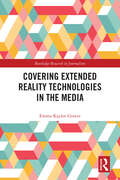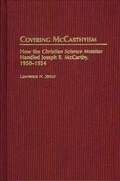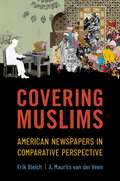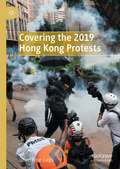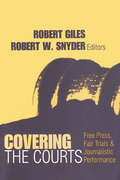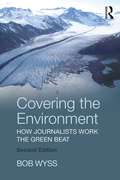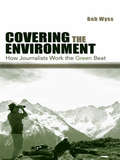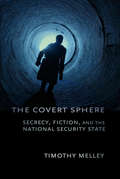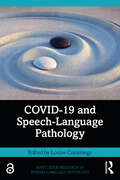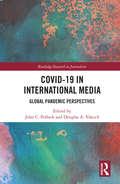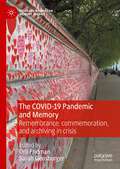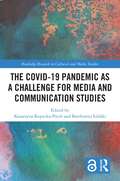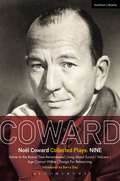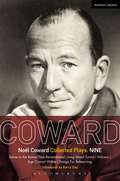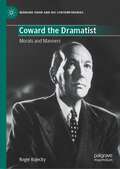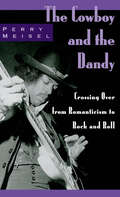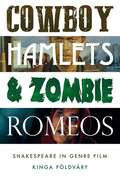- Table View
- List View
Covering Extended Reality Technologies in the Media (Routledge Research in Journalism)
by Emma Kaylee GravesThis book presents a study of the news coverage of extended reality technologies (virtual, augmented and mixed reality; or XR) and how this news corresponds with the marketing of XR products. Focusing on a group of recently emerging technological products, the book offers in-depth analysis of the news coverage of XR technologies and explores the overlap between news discourse and promotional discourse by comparing the way these products are framed in the news and their marketing materials. Using both quantitative and qualitative data, it discusses the topics covered in XR news, as well as the sources used and the specific framing techniques that appear in both XR news and marketing materials. In addition to these findings, it also provides a set of frame categories that can be used by other researchers analysing the media coverage of emerging technologies. Ultimately arguing that the news represents XR in such a way that treats readers as consumers instead of citizens, prioritising the interests of XR companies rather than news audiences, this book will be of interest to students and researchers in media and communications, discourse studies, journalism, PR and marketing and innovation studies, as well as XR practitioners.
Covering McCarthyism: How the Christian Science Monitor Handled Joseph R. McCarthy, 1950-1954 (Contributions to the Study of Mass Media and Communications)
by Lawrence N. StroutStrout examines how the Christian Science Monitor, a highly influential newspaper of the era, covered Joseph R. McCarthy and McCarthyism from the Senator's Lincoln Day speech in February 1950 through his censure in December 1954. Through his in-depth examination of the Monitor's interoffice communications, Strout examines how the Monitor's coverage compared with other elite and popular press newspapers and how the pressures associated with McCarthyism affected individuals at the Monitor.An extensive review of the Monitor's editorials and news articles suggests that it was remarkably thorough and fair in its reporting, while still being outspoken, but responsible in its criticism. While many newspapers attacked McCarthy personally, the Monitor concentrated on the actions of the junior senator and the negative effects they were having at home and abroad. As Strout sees it, the Monitor served as a voice of moderation, while simultaneously being a persistent critic of McCarthy's tactics.
Covering Muslims: American Newspapers in Comparative Perspective
by Erik Bleich A. Maurits van der VeenAn examination of how American newspaper articles on Muslims are strikingly negative by any measure. For decades, scholars and observers have criticized negative media portrayals of Muslims and Islam. Yet most of these critiques are limited by their focus on one specific location, a limited time period, or a single outlet. In Covering Muslims, Erik Bleich and A. Maurits van der Veen present the first systematic, large-scale analysis of American newspaper coverage of Muslims through comparisons across groups, time, countries, and topics. The authors demonstrate conclusively that coverage of Muslims is remarkably negative by any measure. They show that American newspapers have been consistently negative across the two-decade period between 1996 and 2016 and that articles on Muslims are more negative than those touching on groups as diverse as Catholics, Jews, Hindus, African Americans, Latinos, Mormons, or atheists. Strikingly, even articles about mundane topics tend to be negative. The authors suggest that media outlets both within and outside the United States may contribute to pervasive Islamophobia and they encourage readers and journalists to "tone check" the media rather than simply accepting negative associations with Muslims or other marginalized groups.
Covering Muslims: American Newspapers in Comparative Perspective
by Erik Bleich A. Maurits van der VeenAn examination of how American newspaper articles on Muslims are strikingly negative by any measure. For decades, scholars and observers have criticized negative media portrayals of Muslims and Islam. Yet most of these critiques are limited by their focus on one specific location, a limited time period, or a single outlet. In Covering Muslims, Erik Bleich and A. Maurits van der Veen present the first systematic, large-scale analysis of American newspaper coverage of Muslims through comparisons across groups, time, countries, and topics. The authors demonstrate conclusively that coverage of Muslims is remarkably negative by any measure. They show that American newspapers have been consistently negative across the two-decade period between 1996 and 2016 and that articles on Muslims are more negative than those touching on groups as diverse as Catholics, Jews, Hindus, African Americans, Latinos, Mormons, or atheists. Strikingly, even articles about mundane topics tend to be negative. The authors suggest that media outlets both within and outside the United States may contribute to pervasive Islamophobia and they encourage readers and journalists to "tone check" the media rather than simply accepting negative associations with Muslims or other marginalized groups.
Covering the 2019 Hong Kong Protests
by Luwei Rose LuqiuThis book explores the impact of governmental, institutional, and individual factors on journalists covering protests, using the 2019 Hong Kong Anti-Extradition Bill Movement as a case study. The discussion surveys the challenges frontline journalists have faced while covering protests that unfolded in complex and rapidly evolving geopolitical contexts and media ecologies. Complementing this is an analysis of the Chinese government’s efforts to suppress social movements by curtailing press freedom to silence criticism of the government and keep information about the protest efforts from the public. Separate chapters explore these issues from the perspectives of the citizen journalists, student journalists, and independent journalists who have played key roles in the most recent social movements in Hong Kong. It concludes with a look at the future of press freedom in the city after the passage of the National Security Law.
Covering the Courts: Free Press, Fair Trials, and Journalistic Performance (Media Studies)
by Robert GilesCovering the Courts shows how writers and journalists deal with present-day major trials, such as those involving Timothy McVeigh and O.J. Simpson. The volume features such outstanding contributors as Linda Deutsch and Fred Graham, and provides an in-depth look at the performance of the court in an age of heightened participation by reporters, camera operators, social scientists, major moguls of network radio and television, and advocates of special causes.The volume does far more than discuss specific cases. Indeed, it is a major tool in the study of the new relationships between a free press and a fair trial. Interestingly, a consensus is described in which the parties involved in efforts to balance freedom of the press and the right to a fair trial are moving in tandem. In this regard, sensitive issues ranging from the universality of law to the particularity of racial, religious, and gender claims, are explored with great candor.The volume also turns the intellectual discourse to its major players: the members of the press, the lawyers, and the judiciary. Has there been a shift from reporting functions to entertainment values? Does television and live presentation shift the burden from the contents of a case to the photogenic and star quality of players? What excites and intrigues the public: serious disturbances to the peace and mass mayhem, such as the Oklahoma bombings or sexual adventures of entertainment and sports figures? The findings are sometimes disturbing, but the reading is never dull. This book will be of interest to journalists, lawyers, and the interested general public.This volume is the latest in the Transaction Media Studies Series edited by Everette E. Dennis, dean of the school of communication at Fordham University. The volume itself is edited by Robert Giles, the editor, and Robert W. Snyder, the managing editor, of Media Studies Journal. The original contributions were initially presented at The Freedom Forum and its Media Studies Center.
Covering the Courts: Free Press, Fair Trials, and Journalistic Performance (Media Studies)
by Robert GilesCovering the Courts shows how writers and journalists deal with present-day major trials, such as those involving Timothy McVeigh and O.J. Simpson. The volume features such outstanding contributors as Linda Deutsch and Fred Graham, and provides an in-depth look at the performance of the court in an age of heightened participation by reporters, camera operators, social scientists, major moguls of network radio and television, and advocates of special causes.The volume does far more than discuss specific cases. Indeed, it is a major tool in the study of the new relationships between a free press and a fair trial. Interestingly, a consensus is described in which the parties involved in efforts to balance freedom of the press and the right to a fair trial are moving in tandem. In this regard, sensitive issues ranging from the universality of law to the particularity of racial, religious, and gender claims, are explored with great candor.The volume also turns the intellectual discourse to its major players: the members of the press, the lawyers, and the judiciary. Has there been a shift from reporting functions to entertainment values? Does television and live presentation shift the burden from the contents of a case to the photogenic and star quality of players? What excites and intrigues the public: serious disturbances to the peace and mass mayhem, such as the Oklahoma bombings or sexual adventures of entertainment and sports figures? The findings are sometimes disturbing, but the reading is never dull. This book will be of interest to journalists, lawyers, and the interested general public.This volume is the latest in the Transaction Media Studies Series edited by Everette E. Dennis, dean of the school of communication at Fordham University. The volume itself is edited by Robert Giles, the editor, and Robert W. Snyder, the managing editor, of Media Studies Journal. The original contributions were initially presented at The Freedom Forum and its Media Studies Center.
Covering the Environment: How Journalists Work the Green Beat
by Bob WyssThis practical primer explains the primary issues in writing about the environment, identifies who to go to and where to find sources, and offers examples of writing and reporting the beat. Observations and story excerpts from experienced journalists provide real-world context both for those in the U.S. as well as internationally. Practice story assignments, resources, and a glossary of critical terms gives budding journalists all the tools needed to cover the green beat. Updated with detailed coverage of how companies and climate change have evolved over the past decade, this second edition expands upon the digital sphere and the myriad ways that deadline, multimedia and mobile reporting have changed environmental journalism. Including consideration of issues such as the water crisis in Flint, Michigan, and the GMO controversy, this new edition provides a fresh take on the green beat with a newly organized table of contents and a guide to freelance and entrepreneurial journalism anywhere in the world. Contents include: • an overview and history of the environment and journalism, spotlighting the most significant issues in the beat; • guidance on understanding environmental and health science, ranging from issues of risk, to scientific research and studies, to interviewing scientists; • insights into government and regulatory communities and environmental advocates on all sides of the political spectrum and internationally; • assistance in accessing public records and conducting digital and computer-assisted reporting; • guidance in writing the story for print, broadcast and internet audiences; • an examination of the future of journalism and news coverage of the environment in the U.S. and throughout the world.
Covering the Environment: How Journalists Work the Green Beat
by Bob WyssThis practical primer explains the primary issues in writing about the environment, identifies who to go to and where to find sources, and offers examples of writing and reporting the beat. Observations and story excerpts from experienced journalists provide real-world context both for those in the U.S. as well as internationally. Practice story assignments, resources, and a glossary of critical terms gives budding journalists all the tools needed to cover the green beat. Updated with detailed coverage of how companies and climate change have evolved over the past decade, this second edition expands upon the digital sphere and the myriad ways that deadline, multimedia and mobile reporting have changed environmental journalism. Including consideration of issues such as the water crisis in Flint, Michigan, and the GMO controversy, this new edition provides a fresh take on the green beat with a newly organized table of contents and a guide to freelance and entrepreneurial journalism anywhere in the world. Contents include: • an overview and history of the environment and journalism, spotlighting the most significant issues in the beat; • guidance on understanding environmental and health science, ranging from issues of risk, to scientific research and studies, to interviewing scientists; • insights into government and regulatory communities and environmental advocates on all sides of the political spectrum and internationally; • assistance in accessing public records and conducting digital and computer-assisted reporting; • guidance in writing the story for print, broadcast and internet audiences; • an examination of the future of journalism and news coverage of the environment in the U.S. and throughout the world.
Covering the Environment: How Journalists Work the Green Beat
by Robert L. WyssCovering the Environment serves as a primer for future and current journalists reporting on environmental issues across all types of media. This practical resource explains the primary issues in writing on the environment, identifies who to go to and where to find sources, and offers examples on writing and reporting the beat. It also provides background to help environmental journalists identify their audiences and anticipate reactions to environmental news. This primer emphasizes the role of environmental journalists not as environmental advocates but as reporters attempting to accurately and fairly report the news. Contents include: An overview and history of the environment and journalism, spotlighting the most significant issues in the beat Guidance on understanding environmental and health science, ranging from issues of risk, to scientific research and studies, to interviewing scientists Insights into government and regulatory communities and environmental advocates on all sides of the political spectrum Assistance in accessing public records and conducting computer-assisted reporting Guidance in writing the story for print, broadcast and Internet audiences An examination of the future of journalism and coverage of the environment. Observations and story excerpts from experienced journalists provide a "real world" component, illuminating the practice of environmental journalism. Additional features in each chapter include study questions, story assignments and resources for additional information. The book also provides a glossary of environmental, science, regulator and journalism terms, as well as a reference section and index. This resource has been developed to train advanced undergraduate and graduate journalism students to cover the science and environment community, writing print and broadcast stories to a general audience. It also serves as a guide for working journalists who cover the environment in their work.
The Covert Sphere: Secrecy, Fiction, and the National Security State
by Timothy MelleyIn December 2010 the U.S. Embassy in Kabul acknowledged that it was providing major funding for thirteen episodes of Eagle Four—a new Afghani television melodrama based loosely on the blockbuster U.S. series 24. According to an embassy spokesperson, Eagle Four was part of a strategy aimed at transforming public suspicion of security forces into something like awed respect. Why would a wartime government spend valuable resources on a melodrama of covert operations? The answer, according to Timothy Melley, is not simply that fiction has real political effects but that, since the Cold War, fiction has become integral to the growth of national security as a concept and a transformation of democracy. In The Covert Sphere, Melley links this cultural shift to the birth of the national security state in 1947. As the United States developed a vast infrastructure of clandestine organizations, it shielded policy from the public sphere and gave rise to a new cultural imaginary, "the covert sphere." One of the surprising consequences of state secrecy is that citizens must rely substantially on fiction to "know," or imagine, their nation’s foreign policy. The potent combination of institutional secrecy and public fascination with the secret work of the state was instrumental in fostering the culture of suspicion and uncertainty that has plagued American society ever since—and, Melley argues, that would eventually find its fullest expression in postmodernism. The Covert Sphere traces these consequences from the Korean War through the War on Terror, examining how a regime of psychological operations and covert action has made the conflation of reality and fiction a central feature of both U.S. foreign policy and American culture. Melley interweaves Cold War history with political theory and original readings of films, television dramas, and popular entertainments—from The Manchurian Candidate through 24—as well as influential writing by Margaret Atwood, Robert Coover, Don DeLillo, Joan Didion, E. L. Doctorow, Michael Herr, Denis Johnson, Norman Mailer, Tim O’Brien, and many others.
COVID-19 and Speech-Language Pathology (Routledge Research in Speech-Language Pathology)
by Louise CummingsThis collection is the first of its kind to examine the impact of the COVID-19 pandemic on the caseloads and clinical practice of speech-language pathologists. The volume synthesises existing data on the wide-ranging effects of COVID-19 on the communication, swallowing, and language skills of individuals with COVID infection. Featuring perspectives of scholars and practitioners from around the globe, the book examines the ways in which clinicians have had to modify their working practices to prioritise patient and clinician safety, including the significant increase in the use of telepractice during the pandemic. The volume also reflects on changes in training and education which have seen educators in the field redesign their clinical practicum in order to best prepare students for professional practice in an age of COVID-19 and beyond, as the field continues to grapple with the long-term effects of the pandemic. Offering a holistic treatment of the impact of COVID-19 on the work of speech-language pathologists, this book will be of interest to students, researchers, and clinicians working in the discipline. Chapters 5, 6, 10, and 13 of this book are freely available as downloadable Open Access PDFs under a Creative Commons Attribution-Non Commercial-No Derivatives 4.0 license available at http://www.taylorfrancis.com
COVID-19 and Speech-Language Pathology (Routledge Research in Speech-Language Pathology)
by Louise CummingsThis collection is the first of its kind to examine the impact of the COVID-19 pandemic on the caseloads and clinical practice of speech-language pathologists. The volume synthesises existing data on the wide-ranging effects of COVID-19 on the communication, swallowing, and language skills of individuals with COVID infection. Featuring perspectives of scholars and practitioners from around the globe, the book examines the ways in which clinicians have had to modify their working practices to prioritise patient and clinician safety, including the significant increase in the use of telepractice during the pandemic. The volume also reflects on changes in training and education which have seen educators in the field redesign their clinical practicum in order to best prepare students for professional practice in an age of COVID-19 and beyond, as the field continues to grapple with the long-term effects of the pandemic. Offering a holistic treatment of the impact of COVID-19 on the work of speech-language pathologists, this book will be of interest to students, researchers, and clinicians working in the discipline. Chapters 5, 6, 10, and 13 of this book are freely available as downloadable Open Access PDFs under a Creative Commons Attribution-Non Commercial-No Derivatives 4.0 license available at http://www.taylorfrancis.com
COVID-19 in International Media: Global Pandemic Perspectives (Routledge Research in Journalism)
by John C. Pollock; Douglas A. VakochCovid-19 in International Media: Global Pandemic Responses is one of the first books uniting an international team of scholars to investigate how media address critical social, political, and health issues connected to the 2020-21 COVID-19 outbreak. The book evaluates unique civic challenges, responsibilities, and opportunities for media worldwide, exploring pandemic social norms that media promote or discourage, and how media serve as instruments of social control and resistance, or of cooperation and representation. These chapters raise significant questions about the roles mainstream or citizen journalists or netizens play or ought to play, enlightening audiences successfully about scientific information on COVID-19 in a pandemic that magnifies social inequality and unequal access to health care, challenging popular beliefs about health and disease prevention and the role of government while the entire world pays close attention. This book will be of interest to students and faculty of communication studies and journalism, departments of public health, sociology, and social marketing.
COVID-19 in International Media: Global Pandemic Perspectives (Routledge Research in Journalism)
by John C. Pollock Douglas A. VakochCovid-19 in International Media: Global Pandemic Responses is one of the first books uniting an international team of scholars to investigate how media address critical social, political, and health issues connected to the 2020-21 COVID-19 outbreak. The book evaluates unique civic challenges, responsibilities, and opportunities for media worldwide, exploring pandemic social norms that media promote or discourage, and how media serve as instruments of social control and resistance, or of cooperation and representation. These chapters raise significant questions about the roles mainstream or citizen journalists or netizens play or ought to play, enlightening audiences successfully about scientific information on COVID-19 in a pandemic that magnifies social inequality and unequal access to health care, challenging popular beliefs about health and disease prevention and the role of government while the entire world pays close attention. This book will be of interest to students and faculty of communication studies and journalism, departments of public health, sociology, and social marketing.
The COVID-19 Pandemic and Memory: Remembrance, commemoration, and archiving in crisis (Palgrave Macmillan Memory Studies)
by Orli Fridman Sarah GensburgerThis book offers a platform for the analysis of commemorative and archiving practices as they were shaped, expanded, and developed during the Covid-19 lockdown periods in 2020 and the years that followed. By offering an extensive global view of these changes as well as of the continuities that went with them, the book enters a dialogue with what has emerged as an initial response to the pandemic and the ways in which it has affected memory and commemoration.The book aims to critically and empirically engage with this abundance of memory to understand both memorialization of the pandemic and commemoration during the pandemic: what happened then to commemorative practices and rituals around the world? How has the Covid-19 pandemic been archived and remembered? What will remembering it actually entail, and what will it mean in the future? Where did the Covid memory boom come from? Who was behind it, how did it emerge, and in what socialconfigurations did it evolve?
The Covid-19 Pandemic as a Challenge for Media and Communication Studies (Routledge Research in Cultural and Media Studies)
by Katarzyna Kopecka-PiechThis truly interdisciplinary volume brings together a diverse group of scholars to explore changes in the significance of media and communication in the era of pandemic. The book answers two interrelated questions: how media and communication reality changed during the first wave of the COVID-19 pandemic, and how media and communication were effectively studied during this time. The book presents changes in media and communication in three areas: media production, media content, and media usage contexts. It then describes the theoretical and practical, methodological, technical, organizational, and ethical challenges in conducting research in circumstances of sudden change in research conditions, emergency situations and developing crises. Drawing on various theoretical studies and empirical research, the volume illustrates the principles and results of applying diverse research methods to the changing role of media in a pandemic and offers good practices and guidance to address the problems in implementing research projects in a time of sudden difficulties and challenges. This diverse and interdisciplinary book will be of significance to scholars and researchers in media studies, communication studies, research methods, sociology, anthropology, and cultural studies.
The Covid-19 Pandemic as a Challenge for Media and Communication Studies (Routledge Research in Cultural and Media Studies)
by Katarzyna Kopecka-Piech Bart 322 Omiej 321 ÓdzkiThis truly interdisciplinary volume brings together a diverse group of scholars to explore changes in the significance of media and communication in the era of pandemic. The book answers two interrelated questions: how media and communication reality changed during the first wave of the COVID-19 pandemic, and how media and communication were effectively studied during this time. The book presents changes in media and communication in three areas: media production, media content, and media usage contexts. It then describes the theoretical and practical, methodological, technical, organizational, and ethical challenges in conducting research in circumstances of sudden change in research conditions, emergency situations and developing crises. Drawing on various theoretical studies and empirical research, the volume illustrates the principles and results of applying diverse research methods to the changing role of media in a pandemic and offers good practices and guidance to address the problems in implementing research projects in a time of sudden difficulties and challenges. This diverse and interdisciplinary book will be of significance to scholars and researchers in media studies, communication studies, research methods, sociology, anthropology, and cultural studies.
COVID-19 und die Sportkommunikation: Der Einfluss der Corona-Pandemie auf Sport, Medien und Journalismus
by Jörg-Uwe Nieland Thomas HorkyCOVID-19 hat die Sportkommunikation nachhaltig verändert. Der Band bietet empirische Analysen, Einschätzungen und theoretische Ansätze sowie Erfahrungsberichte aus der Praxis zum Einfluss der Corona-Pandemie auf Medien, Journalismus und Sport. Aus unterschiedlichen Perspektiven schauen Wissenschaftlerinnen und Wissenschaftler sowie Personen aus der Praxis auf die Veränderungen in verschiedenen Medien- und Sportorganisationen sowie den Wandel von Produktions- und Arbeitsbedingungen innerhalb der Sportkommunikation. Gleichzeitig lassen sich erste Prognosen für einen Ausblick auf die Zukunft des Mediensports ableiten.
Coward Plays: Salute to the Brave/Time Remembered; Long Island Sound; Volcano; Age Cannot Wither; Design For Rehearsing (World Classics)
by Noël CowardCoward Plays: 9 offers up a fascinating selection of Noël Coward's lesser-known works. Salute to the Brave/Time Remembered (1940) follows Leila Heseldyne after she has fled to America, leaving a war-torn Britain and her husband behind; Long Island Sound(1947) sees a writer coerced into a riotous flock of high flying society people with turbulent results; and Volcano (1957) depicts a volcanic eruption as it punctuates the dubious conduct of six individuals on a fictional South Sea island. This volume also includes Design for Rehearsing (1933) was Coward's private satire on the way he , Alfred Lunt and Lynn Fontanne worked on Design for Living. Age Cannot Wither (1967), Coward's last and unfinished play completes the collection as it portrays the boozy reunion of three women in their sixties, who meet without fail every year to reminisce. Together, these works offer a new and intriguing insight into Coward the playwright and his oeuvre that extends well beyond his most well-known works such as Private Lives, Blithe Spirit and Hay Fever. The volume is introduced by Coward expert and scholar Barry Day.
Coward Plays: Salute to the Brave/Time Remembered; Long Island Sound; Volcano; Age Cannot Wither; Design For Rehearsing (World Classics)
by Noël CowardCoward Plays: 9 offers up a fascinating selection of Noël Coward's lesser-known works. Salute to the Brave/Time Remembered (1940) follows Leila Heseldyne after she has fled to America, leaving a war-torn Britain and her husband behind; Long Island Sound(1947) sees a writer coerced into a riotous flock of high flying society people with turbulent results; and Volcano (1957) depicts a volcanic eruption as it punctuates the dubious conduct of six individuals on a fictional South Sea island. This volume also includes Design for Rehearsing (1933) was Coward's private satire on the way he , Alfred Lunt and Lynn Fontanne worked on Design for Living. Age Cannot Wither (1967), Coward's last and unfinished play completes the collection as it portrays the boozy reunion of three women in their sixties, who meet without fail every year to reminisce. Together, these works offer a new and intriguing insight into Coward the playwright and his oeuvre that extends well beyond his most well-known works such as Private Lives, Blithe Spirit and Hay Fever. The volume is introduced by Coward expert and scholar Barry Day.
Coward the Dramatist: Morals and Manners (Bernard Shaw and His Contemporaries)
by Roger KojeckyDiscussions of Coward’s achievement in the theatre between 1920 and 1966 have tended to stay with the colourful biography. The more analytical literary approach adopted here places Coward’s success in its wider theatrical context, making the connections with the work of other dramatists. He developed his technique according to what worked with theatre audiences. Taking up the well-made play, he brought in a more colloquial dialogue, explored, for instance, the morality and psychology of marriage and free love, and frequently exploited the dramatic possibilities of characters grouped into two camps. The book considers both the ‘pleasant’ and ‘unpleasant’ plays (to use the Shavian terms), and the episodic patriotic plays. It Includes Coward’s ambivalent approach to the ‘theatre of war’ in the 20th century. (123)
The Cowboy and the Dandy: Crossing Over from Romanticism to Rock and Roll
by Perry MeiselWhat is rock and roll and where does it come from? In this adventurous new study of music, literature, and culture, Perry Meisel shows how rock and roll joins Romanticism and the blues tradition by focusing on the preoccupation with boundaries that are common to both--the boundaries between freedom and irony, country and city, and cowboy and dandy. Meisel traces the emergence of rock and roll out of jazz and Romantic culture alike as he examines, in a series of juxtaposed chapters, rhythm and blues, Emerson and the cowboy, urban blues, the dandy and psychedelia, Willa Cather, Miles Davis, Virginia Woolf, and 1960s rock. In the process, Meisel shows how the presumable difference between high and mass or pop culture disappears when both turn out to have similar structures. He also reveals how canons emerge inevitably within all traditions rather than being imposed upon them from without.
Cowboy Hamlets and zombie Romeos: Shakespeare in genre film (Manchester University Press)
by Kinga FöldváryThe book presents a systematic method of interpreting Shakespeare film adaptations based on their cinematic genres. Its approach is both scholarly and reader-friendly, and its subject is fundamentally interdisciplinary, combining the findings of Shakespeare scholarship with film and media studies, particularly genre theory. The book is organised into six large chapters, discussing films that form broad generic groups. Part I looks at three genres from the classical Hollywood era (western, melodrama and gangster-noir), while Part II deals with three contemporary blockbuster genres (teen film, undead horror and biopic). Beside a few better-known examples of mainstream cinema, the volume also highlights the Shakespearean elements in several nearly forgotten films, bringing them back to critical attention.
Cowboy Hamlets and zombie Romeos: Shakespeare in genre film (Manchester University Press)
by Kinga FöldváryThe book presents a systematic method of interpreting Shakespeare film adaptations based on their cinematic genres. Its approach is both scholarly and reader-friendly, and its subject is fundamentally interdisciplinary, combining the findings of Shakespeare scholarship with film and media studies, particularly genre theory. The book is organised into six large chapters, discussing films that form broad generic groups. Part I looks at three genres from the classical Hollywood era (western, melodrama and gangster-noir), while Part II deals with three contemporary blockbuster genres (teen film, undead horror and biopic). Beside a few better-known examples of mainstream cinema, the volume also highlights the Shakespearean elements in several nearly forgotten films, bringing them back to critical attention.
